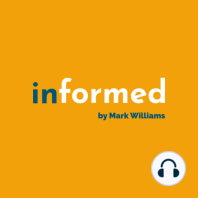40 min listen
Connect vs Follow
FromInformed Podcast by Mark Williams. The podcast for LinkedIn™️ users
ratings:
Length:
52 minutes
Released:
Jan 27, 2018
Format:
Podcast episode
Description
Welcome to episode 195, I had planned to cover a different subject (The dangers of automation - let me know your thoughts on that!) this week but then I got an excellent voicemail question from Giles about the differences between following and connecting and decided to cover that subject in more detail. But before that…… Interesting Stuff I Saw This Week Find the Right Words to Land the Right Job More on this in next weeks episode! The Most Popular Jobs and Companies for College Graduates The top job is also the highest pay! ($95k) Insight Global - a fast growing IT recruitment business Why I changed my LinkedIn profile from Andrea to Andrew She was taken more seriously and less patronised when a man! The algorithm started suggesting connections to higher level men at well-recognised companies. Fascinating experiment …..could be worth a try! LinkedIn Updates Have you noticed the new font? Summaries and headlines may need to be adjusted. New changes to groups may be having some positive impact on groups One manager reports a 10x increase in engagement Unfortunately the changes seemed to have messed up all other notifications! You can now see your own activity in one click, rather than having to go to your profile LinkedIn are clearing ‘moving the furniture’ on desktop at the moment, so many things are not working - especially @mentions and notifications. I also found that only half the comments on one of my posts were showing when I checked on mobile. Suggest you keep an eye on mobile at the moment until things settle down. Connecting and Following As I mentioned, this subject was instigated by a question I received from Giles; Definition: Following someone means that you could see their content and activity in your feed (articles, posts, shares, likes and comments). You can follow anyone on LinkedIn provided their setting allow this. You can follow up to 5000 people who are not your connections. To follow someone simply click on the 3 dot ‘More’ menu at the top of their profile or look for the Follow button on the Activity section of their profile. Connecting A connection is a follower and someone you follow by default. You can unfollow a connection at anytime from the ‘More’ menu. You are allowed up to 30,000 connections. The difference with a connection is that, as well as their activity you are able to see and filter their connections (dependant on their setting), send messages and see their full contact info including their primary email address. Now to Giles question Firstly let me address the question of blocking. This is the only way you can prevent him from following you He will not be alerted to being blocked He will then not be able to find you on LinkedIn, or vice versa The bigger question is whether a competitor following you is a problem or not? What harm can come from him seeing your activity - assuming you are not giving away commercially sensitive information? Following you may make him realise he is way behind and may, in some way intimidate him. A greater threat would come if he started commenting and engaging with your posts This brings up a wider point; The ethics of competition on LinkedIn; Is it ethical to provide advice and demonstrate your knowledge on a competitors post? Should you ever ask for a competitors view via an @mention? When to follow and NOT connect A complete stranger whose content you find interesting A competitor A prospect or intermediary who you wish to engage with Obviously 1 and 3 may be pre-cursors to connecting. Following has been around on LinkedIn for years but still most people just connect, it’s beginning to be understood better but we still have a way to go. When I talk with people who are more familiar with other social networks, I explain the mechanics of LinkedIn as being like a blend of Twitter, where you follow and Facebook where you connect (friend). On LinkedIn you can do either! This weeks question is also about following and comes from Nigel Willis Nigels fir
Released:
Jan 27, 2018
Format:
Podcast episode
Titles in the series (100)
Episode 002: In this episode we cover the following; Review of feedback from the first episode Questions Should I announce that I am looking for a job in my profile? Should I reveal who I am connected to? Interview with Robin Hills News by Informed Podcast by Mark Williams. The podcast for LinkedIn™️ users
